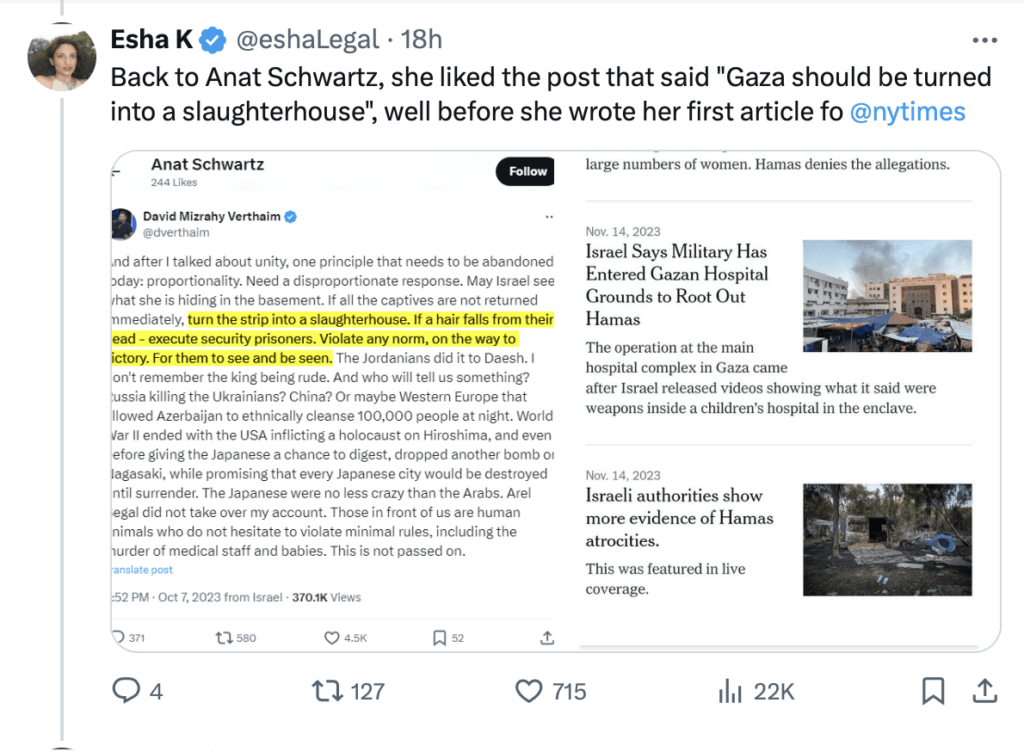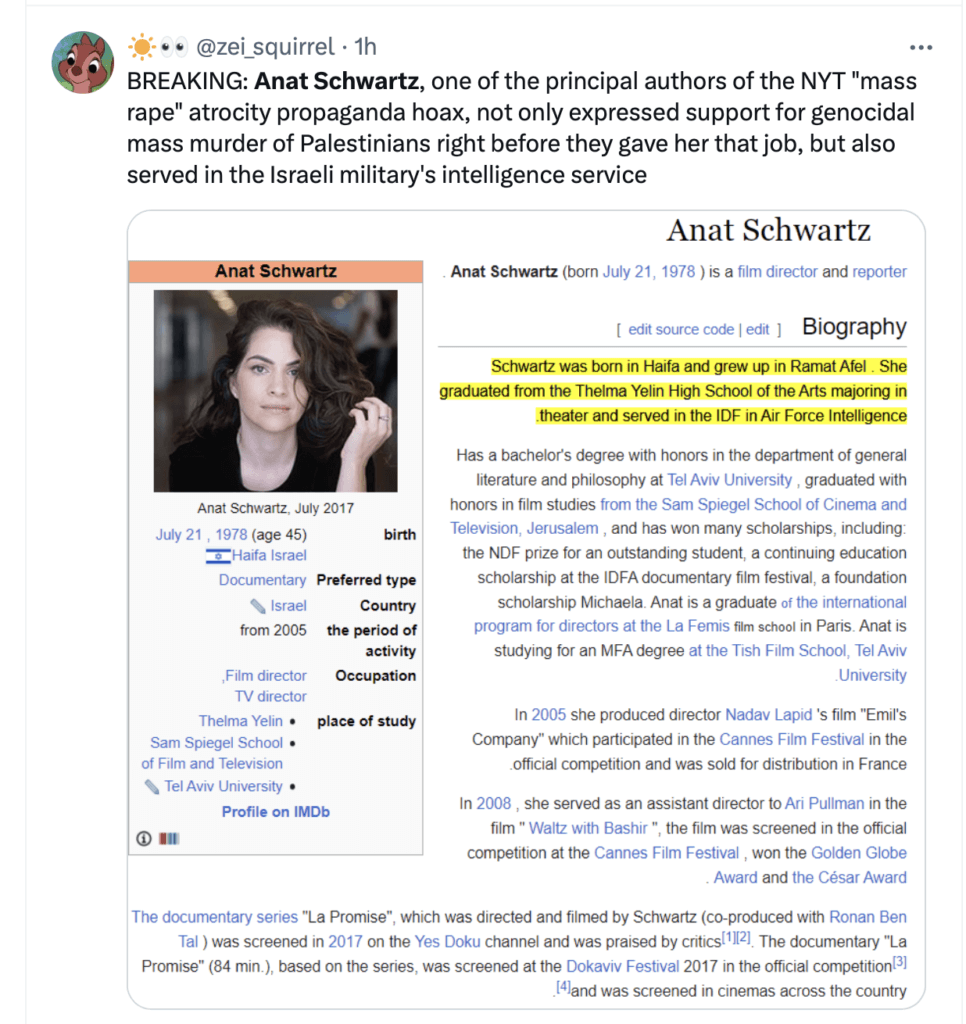New doubts are emerging about the New York Times’s coverage of sexual violence in the October 7 attack. The paper must explain why it broke its own rules by hiring a clearly biased writer who endorsed racist and violent rhetoric toward Palestinians.
BY JAMES NORTH
NEW YORK TIMES HEADQUARTERS. (PHOTO: WIKIPEDIA)
New doubts are emerging about the New York Times’s coverage of sexual violence during the October 7 Hamas-led attack — and the paper owes its readers an open and transparent explanation.
What’s more, its reporting on this issue has become so questionable that it should assign new reporters to go over the entire story again.
The latest questions are centered around Anat Schwartz, an Israeli who co-authored several of the paper’s most widely circulated reports, including the now well-known and scrutinized December 28 article headlined: “‘Screams Without Words’’ How Hamas Weaponized Sexual Violence on Oct. 7.”
Independent researchers scrutinized the online record, and raised serious questions about Schwartz. First, she has apparently never been a reporter but is actually a filmmaker, who the Times suddenly hired in October. You would expect the paper to look for someone with actual journalistic experience, especially for a story as sensitive as this one, written during the fog of war. Surely the paper had enough of its own correspondents on staff who could have been assigned to it.
Next, the researchers found that Schwartz had not hidden her strong feelings online. There are screenshots of her “liking” certain posts that repeated the “40 beheaded baby” hoax, and that endorsed another hysterical post that urged the Israeli army to “turn Gaza into a slaughterhouse,” and called Palestinians “human animals.”

(Just this morning, more evidence emerged online; Schwartz apparently also served in Israeli Military Intelligence.)

Finally, one of her co-authors on two of the reports was Adam Sella, who is her nephew.
Let’s pause here. What would happen if the Times suddenly hired a Palestinian filmmaker with no journalistic background, who had recently publicly “liked” posts that called for “pushing Israeli Jews into the sea,” to co-write several of its most sensitive and contested reports?
(We don’t have to speculate. The Times fired Palestinian photojournalist Hosam Salam in 2022 after one of the pro-Israel media watchdog groups protested about his social media posts.)
After Anat Schwartz’s online history became public, she locked down her accounts and then deleted much of the incriminating content.
The New York Times imposes strict rules on its reporters to maintain the appearance of objectivity. Reporters are not supposed to attend demonstrations of any kind, wear campaign buttons, or post opinions on social media. By hiring Anat Schwartz, the paper clearly violated its own guidelines, and it should publicly explain and apologize.
There’s another related example of how the Times has botched the sexual violence story. One of the first Israeli organizations that arrived on the scene of the Hamas attack was Zaka, a volunteer group that recovers dead bodies. On January 15, Times reporter Sheena Frankel wrote a positive profile of the group; she included 3 or 4 sentences of criticism, only to quickly dismiss them. This site had already raised serious doubts about Zaka weeks earlier, pointing out that “the organization’s volunteers have systematically given false testimonies, and continue repeating them to journalists on behalf of the Israel government.” Then, on January 31, the Israeli daily Haaretz published a long investigation, that highlighted “cases of negligence, misinformation and a fundraising campaign that used the dead as props.” Haaretz cited one Zaka report that said a volunteer had seen a murdered pregnant woman, with the baby still attached by the umbilical cord — before concluding that the incident “simply didn’t happen.”
At this stage, there are serious doubts about many aspects of Israel’s overall account about October 7. Only a genuinely independent and impartial investigation might some day get closer to the truth. But meanwhile, at the very least the New York Times must publicly recognize its errors, and assign new, unbiased reporters to try to clean up its mess.
New doubts are emerging about the New York Times’s coverage of sexual violence during the October 7 Hamas-led attack — and the paper owes its readers an open and transparent explanation.
What’s more, its reporting on this issue has become so questionable that it should assign new reporters to go over the entire story again.
The latest questions are centered around Anat Schwartz, an Israeli who co-authored several of the paper’s most widely circulated reports, including the now well-known and scrutinized December 28 article headlined: “‘Screams Without Words’’ How Hamas Weaponized Sexual Violence on Oct. 7.”
Independent researchers scrutinized the online record, and raised serious questions about Schwartz. First, she has apparently never been a reporter but is actually a filmmaker, who the Times suddenly hired in October. You would expect the paper to look for someone with actual journalistic experience, especially for a story as sensitive as this one, written during the fog of war. Surely the paper had enough of its own correspondents on staff who could have been assigned to it.
Next, the researchers found that Schwartz had not hidden her strong feelings online. There are screenshots of her “liking” certain posts that repeated the “40 beheaded baby” hoax, and that endorsed another hysterical post that urged the Israeli army to “turn Gaza into a slaughterhouse,” and called Palestinians “human animals.”

(Just this morning, more evidence emerged online; Schwartz apparently also served in Israeli Military Intelligence.)

Finally, one of her co-authors on two of the reports was Adam Sella, who is her nephew.
Let’s pause here. What would happen if the Times suddenly hired a Palestinian filmmaker with no journalistic background, who had recently publicly “liked” posts that called for “pushing Israeli Jews into the sea,” to co-write several of its most sensitive and contested reports?
(We don’t have to speculate. The Times fired Palestinian photojournalist Hosam Salam in 2022 after one of the pro-Israel media watchdog groups protested about his social media posts.)
After Anat Schwartz’s online history became public, she locked down her accounts and then deleted much of the incriminating content.
The New York Times imposes strict rules on its reporters to maintain the appearance of objectivity. Reporters are not supposed to attend demonstrations of any kind, wear campaign buttons, or post opinions on social media. By hiring Anat Schwartz, the paper clearly violated its own guidelines, and it should publicly explain and apologize.
There’s another related example of how the Times has botched the sexual violence story. One of the first Israeli organizations that arrived on the scene of the Hamas attack was Zaka, a volunteer group that recovers dead bodies. On January 15, Times reporter Sheena Frankel wrote a positive profile of the group; she included 3 or 4 sentences of criticism, only to quickly dismiss them. This site had already raised serious doubts about Zaka weeks earlier, pointing out that “the organization’s volunteers have systematically given false testimonies, and continue repeating them to journalists on behalf of the Israel government.” Then, on January 31, the Israeli daily Haaretz published a long investigation, that highlighted “cases of negligence, misinformation and a fundraising campaign that used the dead as props.” Haaretz cited one Zaka report that said a volunteer had seen a murdered pregnant woman, with the baby still attached by the umbilical cord — before concluding that the incident “simply didn’t happen.”
At this stage, there are serious doubts about many aspects of Israel’s overall account about October 7. Only a genuinely independent and impartial investigation might some day get closer to the truth. But meanwhile, at the very least the New York Times must publicly recognize its errors, and assign new, unbiased reporters to try to clean up its mess.

No comments:
Post a Comment